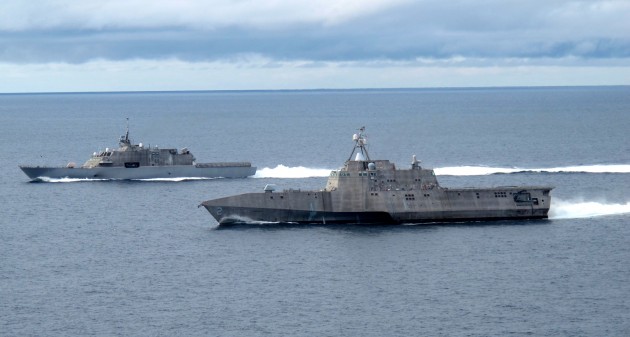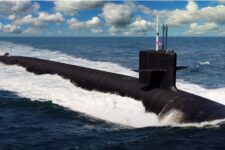
The two Littoral Combat Ship variants, LCS-1 Freedom and LCS-2 Independence.
CAPITOL HILL: The Navy is 90 percent sure its current estimated cost to operate and maintain the controversial Littoral Combat Ship is off target, according to a draft Government Accountability Office report obtained by BreakingDefense.
According to the anonymous authors – whose diagnosis, we should emphasize, is not yet the official and fully vetted conclusion of the GAO, which won’t publish the final report until September – the Navy may go into a critical decision in 2015 about whether to contract for up to 28 more Littoral Combat Ships without enough understanding of the long-term costs, the evolving concepts to sustain the vessels, or even whether they have enough bandwidth to exchange maintenance data with support facilities ashore. As a result of this uncertainty, the GAO draft says the Navy’s own analysts have “only about 10 percent confidence” in the current estimate that it will cost $50.4 billion to “operate and support” a total of 55 LCSs over their 25-year service lives. While such long-term “life cycle costs” are notoriously hard to estimate accurately decades out, a normal program would have at least 50 percent confidence in its figures at this stage.
That’s a big question mark over a big part of the future fleet. While not as well-armed or well-protected as the Navy’s workhorse Arleigh Burke-class Aegis destroyers, the smaller, faster, and less costly Littoral Combat Ships play a crucial role in the Navy’s plans, replacing a host of aging frigates, minesweepers, and other smaller craft. Those vessels are what Rep. Rodney Frelinghuysen (R-NJ) referred to dismissively as “support ships” in a hearing he chaired this morning of the House Appropriations Committee’s panel on defense. The Navy is buying too many such low-end ships, he argued. “Support is one thing,” Frelinghuysen said, but with the Chinese military getting larger and more aggressive, he argued, the US needs “ships that are prepared for combat.”
Actually, replied the Chief of Naval Operations, Adm. Jonathan Greenert, the Navy has 84 of the 88 cruisers and destroyers it thinks it needs: “Where we’re short is in small surface combatants and some of our supporting ships” – precisely the categories LCS is intended to shore up.
The problem is that the Littoral Combat Ship is so different from anything else in service that the Navy is still working out both combat tactics and day-to-day maintenance. The first of the class, LCS-1 Freedom, just arrived on its maiden overseas deployment to Singapore with seawater leaking into its lubricant fluid, the latest of a host of problems. Given the ship’s small size and crew, it relies heavily on shore facilities to perform repairs that larger ships would handle themselves at sea.
That’s the maintenance concept the draft GAO report says the Navy has not adequately worked out. In fact, the Navy has not updated its $50.4 billion estimate for LCS operations and support costs since 2011, and since then some key variables have changed. The planned fleet went down from 55 ships to 52, which would inevitably reduce the cost. Meanwhile the “core crew” per ship went up from 40 to 50, which would probably increase costs. (Each LCS would also embark additional sailors to operate mission-specific “modules” for minesweeping, sub-hunting, or fighting small boats). We say “probably” because the extra sailors might pay for themselves by preventing maintenance problems a smaller crew couldn’t cope with.
Meanwhile the Navy is still thrashing out exactly how it will “support and sustain” the the LCS. The Freedom’s deployment to Singapore is supposed to road-test those concepts, but there are two very different LCS variants, and the other type, the catamaran-like LCS-2 Independence, is still fixing “deficiencies” identified by Navy inspectors and is not currently scheduled for a test deployment of its own.
This blow from GAO comes on top of the leak of an internal Navy study that warned the LCS was not under under-manned but under-armed and under-protected, as reported this morning by our Bloomberg news colleague Tony Capaccio. (We don’t know if the near-simultaneous leaks are coincidence or a coordinated assault by LCS’s critics). That news dominated this morning’s hearing by the House appropriators.
LCS “is being built to the fleet’s lowest level of survivability and [is] not expected to maintain mission capability after a significant hit,” fumed Virginia Democrat Jim Moran. “LCS is ill fitted for combat against anything but small fast-attack boats” and can’t fend off anti-ship missiles of the kind carried by some 67 Iranian warships, he went on, citing the Bloomberg report. “Construction costs have doubled,” he said, from the original $220 million estimate to $440 million apiece.
“The LCS is one of our best programs,” replied Navy Sec. Ray Mabus, “although it did not start out that way.” The costs of the first two ships, Freedom and Independence, did double, but in large part because the Navy decided in the middle of construction to strengthen the hull and mechanical systems to better resist battle damage.
“If the ship takes a hit, it is able to survive, and it returns to base, it doesn’t stay and fight,” added Adm. Greenert. “It has met the standards of that level” of damage resistance. If the Navy should have set a higher standard, he went on, that’s a different debate.
(The original plan was to build LCS to commercial standards for damage-control, which basically means the ship takes long enough to sink that the crew can get off before they drown. Instead, the LCSs are actually being built to what the Navy calls “level one,” enough to take a hit and make it back to port for repairs. Destroyers and other large warships are “level three,” which means they’re supposed to take a hit and keep on fighting back).
“All our ships, even the very best,” are vulnerable to being swamped by an enemy who fires off enough missiles, Greenert continued. That’s why the Navy does not plan to send LCS, or any vessel, into battle on its own. New anti-ship weapons like the Chinese DF-21D ballistic missile, nicknamed the “carrier killer,” but stopping them requires more than a single ship the admiral said.
Electronic warfare aircraft can protect an entire flotilla by jamming the enemy’s targeting systems, for example. Aegis cruisers and destroyers can protect both themselves and other vessels by shooting down incoming missiles. The individual ships can alter their electromagnetic emissions to confuse the missile’s sensors.
“You can jam it, you can spoof it, and as it gets closer you can put a wall of lead up,” Greenert said, referring to the rapid-fire anti-missile guns on the Navy’s Phalanx Close-In Weapons System. (LCS does not actually carry CWIS but it has a similar last-line-of-defense weapon called the Rolling Airframe Missile, RAM). Only when all those systems fail does the ship’s ability to take a hit come into play.
Of course, all this is moot if the fleet can’t afford to build or operate the LCS in the numbers planned. The Navy declined to comment on the draft GAO report, which is still going through a review process that will include Defense Department input: As a matter of policy, the military never discusses GAO documents publicly at this stage. “The Navy fully supports the work of the GAO, which is to provide information to Congress to conduct its oversight of defense programs,” said spokeswoman Capt. Cate Mueller. “We will continue to participate with the audit in question to ensure the Navy information is accurately represented and will provide appropriate comment through the report process.”
We’ll have to see how this latest news on LCS goes over with an already skeptical Capitol Hill. At this point, the program’s immediate challenge isn’t surviving Chinese or Iranian missiles: It’s surviving Congress.
Updated 9:50 am 5/8 to correct number of cruisers and destroyers in fleet.
‘Mind-boggling’: Israel, Ukraine are mere previews of a much larger Pacific missile war, officials warn
MDA Chief Lt. Gen. Heath Collins said more maneuverable missiles and drones have changed the missile defense game: Instead of just preparing to hit “fastballs,” he said, “now we’re hitting sliders and curveballs.”



























